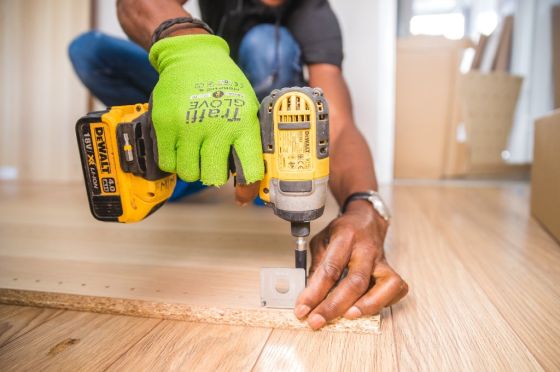
Stanley B&D has released its inaugural Makers Index, in-depth research examining sentiment among young people and their parents to gain a better understanding of the trade and labour shortages in the US.
The Background
Just 16% of students would consider a career in the trades.
Students underestimate trades’ earning potential.
Most students have outdated perceptions of the skills used and demand for trades.
58% of young people have never even spoken to a trade professional to learn more about what they do.
The Method
Stanley B&D surveyed three core audiences - 14-19 High Schoolers, their parents and skilled trade workers. The survey revealed that while young people are not considering work in the trades, and yet over 80% of students and parents think that skilled trade work is a good quality career option. In fact, only around 16% of students are likely to consider the trade option.
Jim Loree, Stanley B&D’s CEO, says that the shortage of skilled workers is one the biggest challenges the US economy is facing. Although made worse by the pandemic, the shortages predated it by many years. He calls for a broad front of measures to solve the challenges, involving, amongst others, school technical education, trade influencers, government, companies, civic leaders and parents.
The Financials
Most young people think that starting pay for skilled trades is around $20,000, but in fact half of current trade professionals with less than ten year’s experience earn more like $50,000 to start.
The trade route is also appealing because the cost of college education is high, while shorter training and on the job education for trades is a quicker way to earn sooner.
When presented with the financial facts that trade school graduates will be $140,000 ahead in the earnings scales compared to a four year degree college student, more than 43% of young people felt more positive about a trade career.
The Skills
Fear of manual labour or lack of skills? It turns out that only 12% of students didn’t like the idea of manual labour, while 40% were more worried about the balance of skills needed by trades. More information about the skills needed and the cutting edge technology used by trades could help counter these ideas. Over 85% of skilled workers reported that their skills and trades were in high demand.
The Influences
It is no surprise that the media influence what young people know about trades and careers in them. Teachers and parents are more common sources of support but few have actually spoken to a tradesperson to find out facts. In fact, only 29% of potential trade students feel well informed about what their earnings and opportunities could be. It’s probably time to devise strategies to involve all the media to rectify this oversight.
Sexist?
A brief look at the average job site will confirm what we all think, namely, that the trades are still heavily male dominated. Men are twice as likely to consider a trade career and parents too, say that they would more likely encourage a son to take up a trade than a daughter. These attitudes need to be changed radically if the skill shortages are to be addressed.
The Background
Stanley Black & Decker hosted a virtual panel to dive deep into the Makers Index results, explore the underlying causes behind the skilled trades labor shortage and shed light on opportunities available within the industry.
The discussion was moderated by TV host and car enthusiast, Cristy Lee, a Stanley Black & Decker CRAFTSMAN Tools Ambassador, and participating panelists included Shannon Lapierre, Chief Communications Officer for Stanley Black & Decker; John Malecki, YouTuber, custom wood and metal worker, and former NFL Lineman; and Abby Leonard, a fourth-year welding apprentice with Poole & Kent.
Empowering Future Makers
In 2021, Stanley Black & Decker launched the Empower Makers Global Impact Challenge, a five-year, up to $25 million commitment to fund vocational skills training and reskilling programs in the construction and manufacturing sectors. The Impact Challenge is expected to skill and reskill up to three million makers over the next five years. The company recently announced the first Makers Grants to 86 nonprofits including high schools, community colleges, construction-focused programs, makerspaces and vocational & trade schools. These recipients will create vital trade programs and help new generations learn how they can help build what matters. The full list of recipients can be found here.
In addition, the company has established partnerships with organizations who are working to drive awareness and help close the skilled trades gap. These partnerships include:
• Rock the Trades, a workforce development initiative which provides opportunities for empowerment to those interested in pursuing a career in the trades, either through mentorships or scholarships.
• Through the company's partnership with the National Association of Manufacturers and the Manufacturing Institute, Stanley Black & Decker supports efforts such as "Creators Wanted," a campaign to build the modern manufacturing workforce of tomorrow.
To learn more about Stanley Black & Decker's Corporate Social Responsibility plan, click here and to learn more about its Environment, Social and Governance strategy, click here.
About the Makers Index
Stanley Black & Decker created two indices as part of this research: the Knowledge & Perception Index and the Advocacy Index. The Knowledge & Perception Index scores factors that influence consideration of a skilled trade career among youths and parents, including familiarity and perceptions, while the Advocacy Index scores factors that influence the likelihood of a skilled trade worker to recommend a skilled trade career to a young person, including job satisfaction.
In this benchmark study, youth scored a 62.4 out of a possible 100 on the Knowledge & Perception Index, while parents scored a noticeably higher 76.0. On their own index, workers scored very high as advocates – at 84.6 – driven by strong satisfaction and positive assessments of their career fields.
Full Makers Index findings and results can be found here.
Survey Methodology
KRC designed and fielded an online survey from August 30 and September 13, 2021, targeting three audiences: Youth (N=801), Parents (N=200), and Skilled Trade Workers (N=502)



